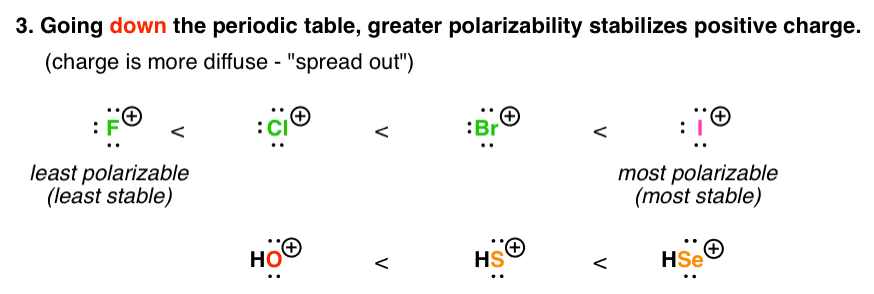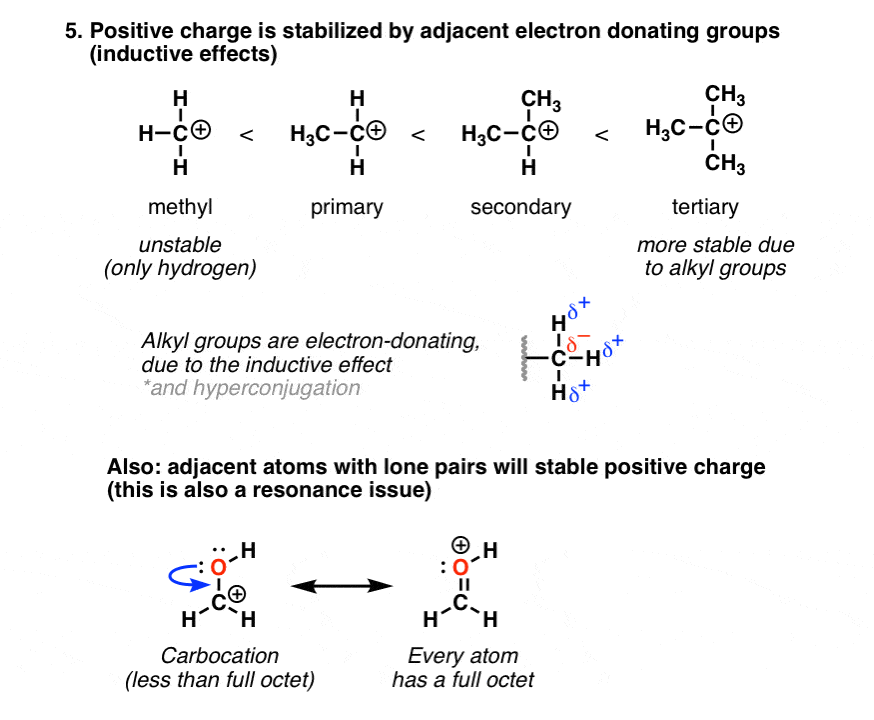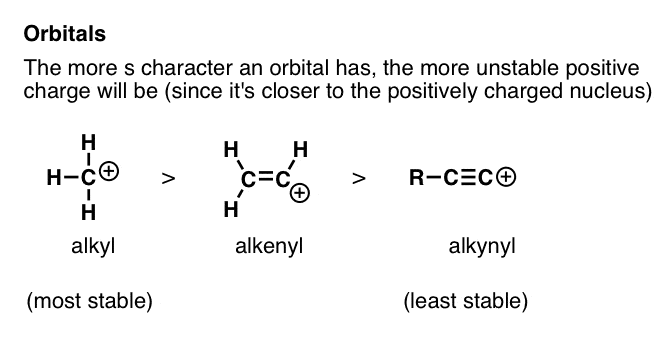Stabilization Of Positive Charge In Organic Chemistry: 7 Key Factors
Just to clarify: make sure you’re familiar with how formal charge can mislead before you read this. These factors determine the stability of “true” positive charges (i.e. low electron densities), not “formal” positive charges.
After discussing 7 factors that stabilize negative charge, it would make sense to talk about 7 factors that stabilize positive charge.
Table of Contents
- The Importance Of Stabilizing Positive Charge In Organic Chemistry
- Factor #1: With Increased Positive Charge Comes Increased Instability
- Factor #2: The Lower The Electronegativity Of The Atom, The Better It Can Stabilize Positive Charge
- Factor #3: The Greater The Polarizability Of The Atom, The Better It Can Stabilize Positive Charge
- Factor #4: Resonance Stabilization – Spreading Positive Charge Out Over A Greater Volume Is Stabilizing
- Factor #5: Increasing The Number Of Alkyl Substituents Adjacent To A Carbocation Will Stabilize Positive Charge
- Factor #6: Electronegativity Of An Atom Increases As The s-Character Of Its Hybridization Increases; This Destabilizes Positive Charge
- Aromaticity Can Also Stabilize Positive Charge
- Tying Together The Factors That Stabilize Positive Charge With The Factors That Stabilize Negative Charge
1. The Importance Of Stabilizing Positive Charge In Organic Chemistry
Anytime you have a reaction where positive charge is being formed, it’s useful to ask: how stable will this new positive charge be? What factors might help to stabilize it? The more stable that positive charge is, the more favorable the reaction will be.
Conversely, anytime you see a reaction where positive charge is being destroyed, it’s useful to ask the same question. If you see that a particularly unstable positive charge is being destroyed, this is going to be particularly favorable.
As with negative charge, there are several major factors worth keeping in mind:
- Opposite charges attract, so positive charges are stabilized through donation of electron density by neighboring atoms.
- High charge densities are unstable. So if charge can be “spread out” or “diffused” somehow, this is stabilizing. Also, if a neighboring group removes electron density from a positively charged atom, this is going to destabilize it (lead to higher charge density).
OK, here we go!
2. Factor #1: With Increased Positive Charge Comes Increased Instability
Simply put, the lower the charge density, the more stable the positive charge will be. For this reason the (ridiculous) case of H4O(2+) is far more unstable than H3O(+) which is more unstable than neutral H2O.

3. Factor #2: The Lower The Electronegativity Of The Atom, The Better It Can Stabilize Positive Charge
Just like high electronegativity stabilizes negative charge, the opposite is true: low electronegativity will result in a more stable positive charge. That helps to explain why cations like Na+, Li+, and K+ are quite innocuous and stable, whereas F+ and Cl+ are not.

4. Factor #3: The Greater The Polarizability Of The Atom, The Better It Can Stabilize Positive Charge
As we go down a column of the periodic table, the atomic radius will increase, which means that the charge density will decrease. (Higher volume = lower density). Since the charge is more “spead out”, the stability of the positive charge will increase.

5. Factor #4: Resonance Stabilization – Spreading Positive Charge Out Over A Greater Volume Is Stabilizing
Again, “spreading out” positive charge, which is possible when neighboring p orbitals can participate in resonance, is a stabilizing factor. Resonance stabilizes positive charge.
6. Factor #5: Increasing The Number Of Alkyl Substituents Adjacent To A Carbocation Will Stabilize Positive Charge
If you’re (electron) poor, it helps to have (electron) rich neighbors. Since opposite charges attract, positive charges will be stabilized by neighbors that can donate electrons. The classic example is carbocation stability, which increases as the number of adjacent carbon atoms increases. Another example is π donation, where neighboring atoms with lone pairs can donate their electrons to electron-poor species such as carbocations.

7. Factor #6: Electronegativity Of An Atom Increases As The s-Character Of Its Hybridization Increases; This Destabilizes Positive Charge
Negative charge is stabilized as we go from sp3 to sp2 to sp hybridization (alkyl to alkene to alkyne), since the negative charge is held in orbitals with increasing s-character – closer to the positively charged nucleus.
The opposite is true for positive charge! Having a positive charge in an sp orbital would mean that the positive charge is held more closely to the positively charged nucleus, which is bad! So the stability of positive charge will increase as we go from sp to sp2 to sp3.

8. Aromaticity Can Also Stabilize Positive Charge
This is a special case you usually meet in the early days of Org 2. There are certain types of molecules which possess a special stability called “aromaticity” (see post: Introduction to Aromaticity). Certain molecules that bear positive charge are aromatic: if that’s the case, the positive charge will be extraordinarily stable, like the cyclopropenium and tropylium carbocations. (you can even buy the tropylium carbocation!)
Conversely, there’s a related (but opposite) phenomenon called “antiaromaticity” (see post: Antiaromaticity) where certain molecules are particularly unstable.
If a molecule bearing a positive charge happens to be antiaromatic, it will be even more unstable than normal.

9. Tying Together The Factors That Stabilize Positive Charge With The Factors That Stabilize Negative Charge
Have you noticed how the factors that stabilize positive charge are related to the factors that stabilize negative charge?
1. “Spreading out” stabilizes both negative and positive charges. Resonance, polarizability, decreasing charge density and aromaticity are factors that can stabilize both positive and negative charge.
2. Negative charge is stabilized by adjacent positive charge – such as electronegativity (increasing), increasing s-character, and electron withdrawing groups, and destabilized by adjacent negative charge. (Opposite charges attract, like charges repel).
3. Positive charge is stabilized by adjacent negative charge – such as electron donating groups – and destabilized by adjacent positive charge such as electronegativity (increasing) and increasing s-character of orbitals. (Opposite charges attract, like charges repel).
These 7 factors will help us immensely toward understanding why certain reactions happen and others don’t.

